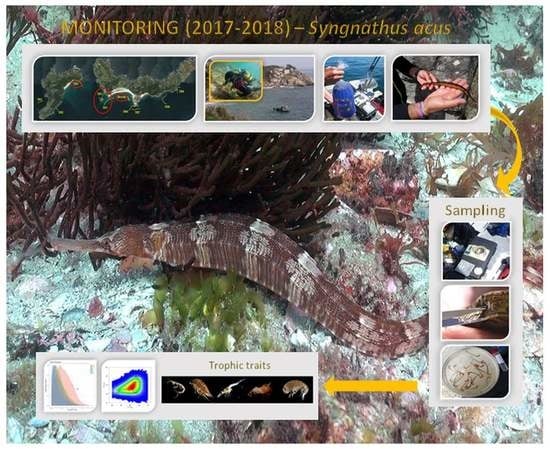Open AccessArticle
Ecological Traits and Trophic Plasticity in The Greater Pipefish Syngnathus acus in the NW Iberian Peninsula
by
Miquel Planas
 Miquel Planas
Miquel Planas
Department of Marine Ecology and Resources, Instituto de Investigaciones Marinas (CSIC), 36208 Vigo, Spain
Submission received: 7 March 2022
/
Revised: 25 April 2022
/
Accepted: 2 May 2022
/
Published: 7 May 2022
Simple Summary
The population of the pipefish Syngnathus acus inhabiting Cíes Archipelago (NW Spain) was monitored in 2017–2018 for spatial and temporal changes in abundances, reproduction traits, trophic niche occupancy, and dietary regimes across reproduction states, through an isotopic (δ13C and δ15N) approach. The population consisted almost exclusively of large adults, whose abundances decreased significantly from mid-autumn after the breeding season. S. acus is a secondary consumer that prefers amphipods, but mature specimens were less selective than immature fish. The present study highlights the outstanding size of the fish and the exceptional occurrence of breeders on the studied area.
Abstract
The great pipefish Syngnathus acus is one of the most representative European syngnathids, being highly associated with seagrass and macroalgal beds. Surprisingly, the ecology of this large ovoviviparous marine fish has received scanty attention. The population inhabiting three sites on Cíes Archipelago (Atlantic Islands National Park, NW Spain) was monitored in 2017–2018 for spatial and temporal changes in abundances, reproduction traits, trophic niche occupancy, and dietary regimes across reproduction states, through an isotopic (δ13C and δ15N) approach. Abundances were highly variable across seasons and sites, decreasing significantly from mid-autumn. The population consisted almost exclusively of large adults that migrate by the end of the breeding season, which extended from mid-spring to summer. Operational sex ratios suggest that the species is sex-role reversed. S. acus is a secondary consumer (Trophic position = 3.36 ± 0.05), preferring amphipods but displaying annual and seasonal dietary plasticity. Mature fish were less selective than immatures (especially females), with a higher preference for amphipods (36–68%) in the former. The second most-preferred prey were carideans, copepods, or isopods, depending on the year and the reproduction state. Overall, the wider trophic niches in females and immature specimens compared to males and mature fish would indicate a higher variability in both the use of prey resources and/or their origin. The present study highlights the trophic plasticity and unique features of S. acus population in the Cíes Archipelago, especially regarding the outstanding size of the fish and the exceptional occurrence of breeders.
Share and Cite
MDPI and ACS Style
Planas, M.
Ecological Traits and Trophic Plasticity in The Greater Pipefish Syngnathus acus in the NW Iberian Peninsula. Biology 2022, 11, 712.
https://doi.org/10.3390/biology11050712
AMA Style
Planas M.
Ecological Traits and Trophic Plasticity in The Greater Pipefish Syngnathus acus in the NW Iberian Peninsula. Biology. 2022; 11(5):712.
https://doi.org/10.3390/biology11050712
Chicago/Turabian Style
Planas, Miquel.
2022. "Ecological Traits and Trophic Plasticity in The Greater Pipefish Syngnathus acus in the NW Iberian Peninsula" Biology 11, no. 5: 712.
https://doi.org/10.3390/biology11050712
APA Style
Planas, M.
(2022). Ecological Traits and Trophic Plasticity in The Greater Pipefish Syngnathus acus in the NW Iberian Peninsula. Biology, 11(5), 712.
https://doi.org/10.3390/biology11050712
Note that from the first issue of 2016, this journal uses article numbers instead of page numbers. See further details
here.
Article Metrics
Article Access Statistics
For more information on the journal statistics, click
here.
Multiple requests from the same IP address are counted as one view.






